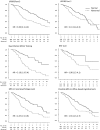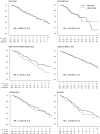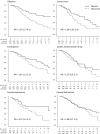Risk and predictors of dementia and parkinsonism in idiopathic REM sleep behaviour disorder: a multicentre study
- PMID: 30789229
- PMCID: PMC6391615
- DOI: 10.1093/brain/awz030
Risk and predictors of dementia and parkinsonism in idiopathic REM sleep behaviour disorder: a multicentre study
Abstract
Idiopathic REM sleep behaviour disorder (iRBD) is a powerful early sign of Parkinson's disease, dementia with Lewy bodies, and multiple system atrophy. This provides an unprecedented opportunity to directly observe prodromal neurodegenerative states, and potentially intervene with neuroprotective therapy. For future neuroprotective trials, it is essential to accurately estimate phenoconversion rate and identify potential predictors of phenoconversion. This study assessed the neurodegenerative disease risk and predictors of neurodegeneration in a large multicentre cohort of iRBD. We combined prospective follow-up data from 24 centres of the International RBD Study Group. At baseline, patients with polysomnographically-confirmed iRBD without parkinsonism or dementia underwent sleep, motor, cognitive, autonomic and special sensory testing. Patients were then prospectively followed, during which risk of dementia and parkinsonsim were assessed. The risk of dementia and parkinsonism was estimated with Kaplan-Meier analysis. Predictors of phenoconversion were assessed with Cox proportional hazards analysis, adjusting for age, sex, and centre. Sample size estimates for disease-modifying trials were calculated using a time-to-event analysis. Overall, 1280 patients were recruited. The average age was 66.3 ± 8.4 and 82.5% were male. Average follow-up was 4.6 years (range = 1-19 years). The overall conversion rate from iRBD to an overt neurodegenerative syndrome was 6.3% per year, with 73.5% converting after 12-year follow-up. The rate of phenoconversion was significantly increased with abnormal quantitative motor testing [hazard ratio (HR) = 3.16], objective motor examination (HR = 3.03), olfactory deficit (HR = 2.62), mild cognitive impairment (HR = 1.91-2.37), erectile dysfunction (HR = 2.13), motor symptoms (HR = 2.11), an abnormal DAT scan (HR = 1.98), colour vision abnormalities (HR = 1.69), constipation (HR = 1.67), REM atonia loss (HR = 1.54), and age (HR = 1.54). There was no significant predictive value of sex, daytime somnolence, insomnia, restless legs syndrome, sleep apnoea, urinary dysfunction, orthostatic symptoms, depression, anxiety, or hyperechogenicity on substantia nigra ultrasound. Among predictive markers, only cognitive variables were different at baseline between those converting to primary dementia versus parkinsonism. Sample size estimates for definitive neuroprotective trials ranged from 142 to 366 patients per arm. This large multicentre study documents the high phenoconversion rate from iRBD to an overt neurodegenerative syndrome. Our findings provide estimates of the relative predictive value of prodromal markers, which can be used to stratify patients for neuroprotective trials.
Keywords: Parkinson’s disease; REM sleep behaviour disorder; dementia with Lewy bodies; multiple system atrophy.
© The Author(s) (2019). Published by Oxford University Press on behalf of the Guarantors of Brain.
Figures




Comment in
-
REM sleep behaviour disorder: an early window for prevention in neurodegeneration?Brain. 2019 Mar 1;142(3):498-501. doi: 10.1093/brain/awz014. Brain. 2019. PMID: 30810213 Free PMC article.
Similar articles
-
Evolution of prodromal Parkinson's disease and dementia with Lewy bodies: a prospective study.Brain. 2019 Jul 1;142(7):2051-2067. doi: 10.1093/brain/awz111. Brain. 2019. PMID: 31111143
-
Progression of clinical markers in prodromal Parkinson's disease and dementia with Lewy bodies: a multicentre study.Brain. 2023 Aug 1;146(8):3258-3272. doi: 10.1093/brain/awad072. Brain. 2023. PMID: 36881989
-
Neurodegenerative disease status and post-mortem pathology in idiopathic rapid-eye-movement sleep behaviour disorder: an observational cohort study.Lancet Neurol. 2013 May;12(5):443-53. doi: 10.1016/S1474-4422(13)70056-5. Epub 2013 Apr 3. Lancet Neurol. 2013. PMID: 23562390
-
REM sleep behavior disorder (RBD).Neurobiol Dis. 2020 Sep;143:104996. doi: 10.1016/j.nbd.2020.104996. Epub 2020 Jun 26. Neurobiol Dis. 2020. PMID: 32599063 Review.
-
REM sleep without atonia and the relation with Lewy body disease.Parkinsonism Relat Disord. 2019 Oct;67:90-98. doi: 10.1016/j.parkreldis.2019.07.007. Epub 2019 Jul 7. Parkinsonism Relat Disord. 2019. PMID: 31326237 Review.
Cited by
-
The clinical diagnosis of Parkinson's disease.Arq Neuropsiquiatr. 2024 Jun;82(6):1-10. doi: 10.1055/s-0043-1777775. Epub 2024 Feb 7. Arq Neuropsiquiatr. 2024. PMID: 38325391 Free PMC article. Review.
-
White matter tract-specific microstructural disruption is associated with depressive symptoms in isolated RBD.Neuroimage Clin. 2022;36:103186. doi: 10.1016/j.nicl.2022.103186. Epub 2022 Sep 7. Neuroimage Clin. 2022. PMID: 36116164 Free PMC article.
-
Cognitive training and promoting a healthy lifestyle for individuals with isolated REM sleep behavior disorder: study protocol of the delayed-start randomized controlled trial CogTrAiL-RBD.Trials. 2024 Jun 28;25(1):428. doi: 10.1186/s13063-024-08265-9. Trials. 2024. PMID: 38943191 Free PMC article.
-
RBDtector: an open-source software to detect REM sleep without atonia according to visual scoring criteria.Sci Rep. 2022 Dec 3;12(1):20886. doi: 10.1038/s41598-022-25163-9. Sci Rep. 2022. PMID: 36463304 Free PMC article.
-
Disclosing the Risk Associated with Isolated REM Behavior Disorder: The Sleep Experts' Perspective.Mov Disord Clin Pract. 2024 May;11(5):488-495. doi: 10.1002/mdc3.13998. Epub 2024 Feb 11. Mov Disord Clin Pract. 2024. PMID: 38341655
References
-
- American Academy of Sleep Medicine TFC, Hauri PJC. The international classification of sleep disorders: diagnostic and coding manual. 2nd edn. Westchester, IL: American Academy of Sleep Medicine; 2007.
-
- Bastien CH, Vallieres A, Morin CM. Validation of the Insomnia Severity Index as an outcome measure for insomnia research. Sleep Med 2001; 2: 297–307. - PubMed
Publication types
MeSH terms
Grants and funding
LinkOut - more resources
Full Text Sources
Other Literature Sources
Medical

